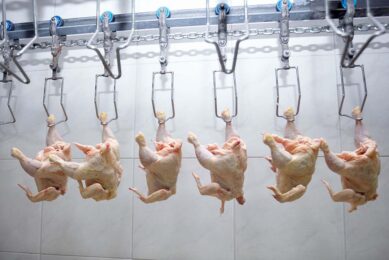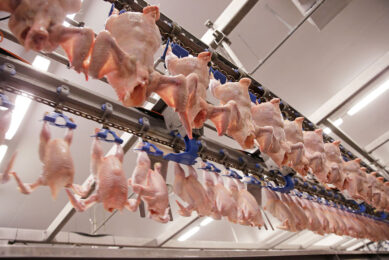Adding value gives brands longer shelf life

Oxidative stability determines not only performance and liveability of chickens, but also their meat quality post-slaughter. It improves shelf life and can be achieved by providing a combination of bioavailable antioxidants to optimise antioxidant capacity during the production phase.
By Dr Alison Leary, Alltech technical manager – Asia Pacific
The variability of customer perception makes it very difficult to define meat quality. In some cases customers may purchase based on colour/appearance, drip loss, flavour, texture, shelf-life, nutritional value, etc., or a combination of any of these factors. From a producer point of view many of these factors are actually linked to one controllable aspect – the cellular integrity of the meat post-mortem. In turn, the oxidative status of the animal while it is alive will determine the cellular integrity of the tissue after processing.
Oxidative status is dependent on the balance between the production of free radicals and the strength of the antioxidant system of the animal. Free radicals are molecules with an unpaired electron, which basically means they are unstable and therefore very reactive. As a result, free radicals can start a chain reaction which ultimately causes significant damage to cells and tissues. Free radicals are commonly produced within all animals – the simple process of energy production from sugar and oxygen within the cell will produce oxygen free radicals. However, animals are protected from these free radicals by the body’s antioxidant system. This system neutralises free radicals and limits the chain reaction they cause.
Oxidative stress
Oxidative stress occurs when more free radicals are produced than the antioxidant system can control. Causes of oxidative stress can be broadly divided into three categories: nutritional, environmental and internal.
• Nutritional causes: diets containing high levels of polyunsaturated fatty acids are more likely to oxidise and produce free radicals and as a result require more antioxidant protection. Many inorganic forms of trace minerals (e.g. mineral salts and sodium selenite) have also been found to promote oxidation and therefore require additional antioxidant protection. Also nutritional deficiencies of any nutrients required by the antioxidant system will promote oxidative stress, including vitamins A and E, and trace minerals.
• Environmental causes: high temperatures and/or humidity along with radiation all contribute to the production of free radicals and therefore oxidative stress.
• Internal causes: disease challenges, be they bacterial, viral or fungal, along with environmental pollutants (heavy metals, pesticides, fungicides, etc.) all contribute to oxidative stress. Mycotoxins decrease the absorption of key antioxidants from the feed and therefore limit the ability of the body to fight free radicals.Intensive farming conditions can increase the risk of many of these causes. The ultimate result of oxidative stress is cellular damage, also known as oxidative damage, as more free radicals are produced than the body can protect against with the antioxidant system. This means the lifecycle of the cell is significantly shortened, which affects performance and immunity while the animal is alive, but also meat quality once the bird is processed.
Effect on nutrient intake
Shortening the lifetime of a cell during grow-out period means the bird has to put more dietary nutrients into replacing cells that have died prematurely, rather than into growth. As a consequence feed conversion is poorer. Oxidative damage also specifically affects immune cells and as a result weakens the immune system of the bird. If animals are suffering from oxidative stress during production it would be common to lose points in feed conversion and have higher mortality. The difficulty in this situation is that many factors contribute to oxidative damage and it is very difficult to measure sub-clinical effects which may result in non-specific, lower than optimum performance.
If the oxidative damage persists to the point of processing and the antioxidant status of cells post-mortem is poor, the cells’ integrity will fail sooner than healthy cells. When the cell integrity fails it is common for the interstitial fluid (the fluid within the cell) to be released, which is commonly known as drip loss. Maintaining the integrity of these cells means that the moisture and flavour are also maintained along with the tenderness and taste of the meat.
Strong antioxidant systems
The importance of strong antioxidant systems in animals, particularly when they are intensively farmed, is very clear. There are several different types of antioxidants, including natural fat-soluble antioxidants (vitamins A, E, carotenoids etc.), water-soluble antioxidants (ascorbic acid, uric acid) and antioxidant enzymes, which are mineral dependent (glutathione peroxidise, GSH-Px; catalase, CAT; superoxide dismutase, SOD). The different types of antioxidants usually have a specific role in the antioxidant defence within cells in animals.
The first line of antioxidant defence normally involves limiting the amount of free-radicals being formed. Generally this is the role of the mineral dependent antioxidant enzymes, like SOD, GSH-Px and CAT. Once free-radicals are formed the second line of oxidant defence is activated, which involves stopping or limiting the chain reaction free-radicals that ultimately result in cell damage or death. The second line of defence commonly, but not exclusively, involves fat- and water antioxidants including vitamins A, E, C, carotenoids and uric acid. The final line of defence involves repairing any damage that has occurred and if this is not possible, removing it using a variety of enzymes.
Cooperative interaction
To optimise the antioxidant status of the animal a combination and cooperative interaction is required between the different antioxidants within the animal. The effects of one such combination on several standard measures of meat quality (colour and drip loss) are highlighted in Figures 1 and 2. Figure 1 indicates that using a combination antioxidant, such as EconomasE from Alltech, even when compared to moderate and high levels of vitamin E, results in a dramatic improvement in meat colour from day of processing through to seven days after processing. Similarly the combination of antioxidants reduced drip loss by between 11 and 28% for up to seven days post-processing. Practically this means more saleable meat is available when using the combination of antioxidants mentioned. This antioxidant combination was developed using a new technology to the animal feed industry, nutrigenomics, which is the study of how nutrients within the feed affect gene expression in animals. This new line of research has given further insight into these antioxidant systems and how to optimise the production, performance and meat quality of animals in intensive farming conditions.
In conclusion, it is clear that oxidative stability determines many of the factors associated not only with performance and liveability during production, but also meat quality post-slaughter. Optimising antioxidant capacity during the production phase is essential to optimise both of these parameters, but a combination of bioavailable antioxidants is necessary to achieve this.
Join 31,000+ subscribers
Subscribe to our newsletter to stay updated about all the need-to-know content in the poultry sector, three times a week. Beheer
Beheer








 WP Admin
WP Admin  Bewerk bericht
Bewerk bericht